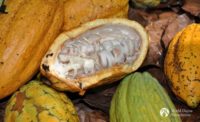For Colombia, cacao is more than just a crop to export – it’s a symbol for peace, prosperity and opportunity.
The country has prioritized cacao not only for its quality – 95 percent of the beans Colombia produces are fine or flavor cacao, according to the International Cocoa Organization (ICCO) – but also because it offers the country a chance to improve farmer livelihoods, bring security to growing regions, and expand its presence on the global stage.
“There is a lot of potential,” said Ricardo Pedroza, U.S. director of ProColombia, a government agency promoting exports, tourism and foreign investment. “The larger producers in the world are looking at Colombia because they know there is the potential to be sourcing in the future.”
Pedroza says Colombia is particularly suited for growing cacao, thanks to its proximity to the equator and the climate diversity brought on by changes in elevation. As a result, Colombian cacao offers a range of flavor notes, including fruity and floral.
In 2016, Colombia’s federal government entered into a peace agreement with the Revolutionary Armed Forces of Colombia (FARC). That same year, the U.S. Department of Agriculture, USAID and several U.S. universities partnered with Corporación Colombiana de Investigación Agropecuaria (CORPOICA), the International Center for Tropical Agriculture (CIAT) and other Colombian agencies for Cacao for Peace, an agreement designed to give Colombia the tools to strengthen its cocoa production and capitalize on the growing global demand for chocolate.
As of 2020, Colombia is the 11th largest producer of cocoa beans at 63,416 tonnes, according to the United Nations’ Food and Agriculture Organization (FAO). Just over 176,000 hectares are currently planted with cacao across 30 regions, but the country has 12.8 million hectares available with medium or high aptitude for commercial cocoa growing, ProColombia said, citing Colombia’s Rural Agricultural Planning Unit.
ProColombia added that 25,000 hectares of illicit crops have been replaced with cacao, with the goal of bringing growers into a legal chain of production. Small and medium growers, represented by 65,000 families, produce the majority of the cacao, Pedroza said.
“This is one of the products we have prioritized in order to allow these people to have options,” he said.
Colombia has built public and private partnerships to increase cocoa-growing productivity through four working units:
- A trade unit, with more than 40 public and private organizations, including ProColombia, Colombia Productiva and the Ministry of Trade
- A metrology unit with more than 30 public and private organizations
- A safety and traceability unit with more than 20 public and private institutions
An information systems unit that has developed the information analysis and diagnosis on the cocoa industry in Colombia
As the world’s third largest producer of green coffee, according to FAO, Colombia has learned much through developing research centers for the crop, Pedroza said. The country plans to do the same for cacao.
“We are taking advantage of that experience to shorten the learning curve and to try to be as quick as possible on the level that is required,” he said.
Deforestation and child labor are major concerns for the global cocoa industry, but Colombia has taken steps to address them, Pedroza said. In 2018, Colombia signed Cacao, Bosques, y Paz (Cacao, Forests, and Peace), an initiative designed to promote peace and deforestation-free production models, as well as improve farmer livelihoods. Colombia has also adopted laws that prohibit child labor.
“If you want to be a dominant or prevalent player in any industry in the future, you have to be sustainable,” he said. “There is no other way to do it. We know that and we are working on it.”
ProColombia says exports of cocoa and its derivatives grew by 13 percent between January and September 2021, registering $292 million. Colombia’s cocoa market is expected to grow by a compound annual growth rate of 6.3 percent between 2019 and 2024.
Colombia exports cocoa and its byproducts to 70 countries, but Mexico, Malaysia, Germany, the United States and Argentina are the top export destinations for cocoa beans, representing more than 90 percent of the market share. At 19 percent, the U.S. is the top buyer of Colombia’s cocoa byproducts and confectionery items, generating $15.8 million.
Exporting isn’t Colombia’s only path for building its connection to cocoa. In December, Colombia became the 52nd member of the ICCO and the ninth country from Latin America to become a member of the organization.
Pedroza noted Colombia’s membership is one example of the country’s commitment to becoming a strong player in international markets.
“Colombia has been formalizing the businesses that the country has. This is a policy not just for cacao, but it’s a policy we’re doing in different areas,” he said. “It’s showing the vision that the country has and the willingness to stay in the long-term.”





